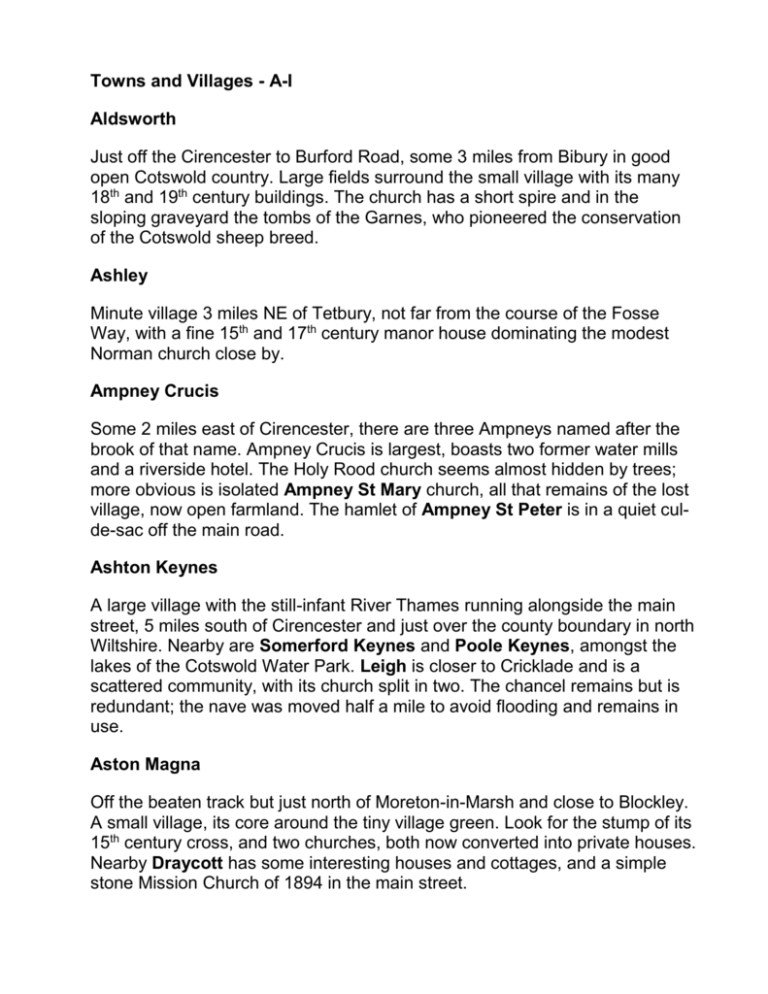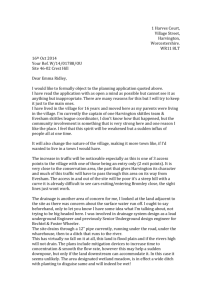Towns and Villages
advertisement

Towns and Villages - A-I Aldsworth Just off the Cirencester to Burford Road, some 3 miles from Bibury in good open Cotswold country. Large fields surround the small village with its many 18th and 19th century buildings. The church has a short spire and in the sloping graveyard the tombs of the Garnes, who pioneered the conservation of the Cotswold sheep breed. Ashley Minute village 3 miles NE of Tetbury, not far from the course of the Fosse Way, with a fine 15th and 17th century manor house dominating the modest Norman church close by. Ampney Crucis Some 2 miles east of Cirencester, there are three Ampneys named after the brook of that name. Ampney Crucis is largest, boasts two former water mills and a riverside hotel. The Holy Rood church seems almost hidden by trees; more obvious is isolated Ampney St Mary church, all that remains of the lost village, now open farmland. The hamlet of Ampney St Peter is in a quiet culde-sac off the main road. Ashton Keynes A large village with the still-infant River Thames running alongside the main street, 5 miles south of Cirencester and just over the county boundary in north Wiltshire. Nearby are Somerford Keynes and Poole Keynes, amongst the lakes of the Cotswold Water Park. Leigh is closer to Cricklade and is a scattered community, with its church split in two. The chancel remains but is redundant; the nave was moved half a mile to avoid flooding and remains in use. Aston Magna Off the beaten track but just north of Moreton-in-Marsh and close to Blockley. A small village, its core around the tiny village green. Look for the stump of its 15th century cross, and two churches, both now converted into private houses. Nearby Draycott has some interesting houses and cottages, and a simple stone Mission Church of 1894 in the main street. The Barringtons These two villages face each other across the river Windrush a little west of Burford. Little Barrington clusters around its sloping green, with the church off down the lane. This combination is one of the most attractive village scenes in the Cotswolds. On the hill, Great Barrington is dominated by Barrington Park; estate influence is clear in the uniformity (pleasing rather than repetitive) of the stone houses and farms, well set into the landscape. This area was extensively quarried for the famous Cotswold building stone. Baunton In the Churn valley just north of Cirencester, Baunton is tiny – one street along the hillside with walks further on. The equally tiny Church of St Mary Magdalene boasts an impressive 14th century wall-painting of St Christopher. Bibury William Morris called Bibury ‘the most beautiful village in England’ and it remains most attractive in its setting alongside the river Coln. Two communities (the other is Arlington) form the village proper, the 14th century Arlington Row providing the focal point; originally a wool store, then altered into weavers cottages and now restored by the National Trust. The low roofline and row of gables make its vernacular style true Cotswold. Opposite, Rack Isle is an open wetland meadow between the river and the millstream from Arlington Mill, now a crafts centre. Next door Bibury Trout Farm is a popular attraction, and Bibury church has a number of Saxon features. Just up the Coln valley is Ablington, enjoying its seclusion, with a fine example of a Cotswold manor house dating from 1590. Birdlip Enjoys an elevated position on the Cotswold scarp and from Barrow Wake viewpoint there are fine views across the Vale of Severn and city of Gloucester to the Malvern Hills. Nearby Crickley Hill Country Park offers woodland walks and similar views from within the ramparts of an Iron Age hill fort, extensively excavated in recent years. Bledington The large green with its stream provides a village focus in the heart of the Cotswolds dance tradition. St Leonard’s church is a fine example of 15th century Cotswold perpendicular style. 4 miles SE of Stow-on-the-Wold, there are several options for walks, including the Oxfordshire Way. Nearby hamlets at Foscote and Bould on the road up to Burford consist of cottages and a farm or two – typical of the quiet Evenlode valley. Blockley One of the larger Cotswold villages and largely unspoilt, midway between Moreton-in-Marsh and Chipping Campden. Once a main centre of the silk industry, which thrived in 18th and 19th centuries but eventually collapsed. The evidence remains in impressive mills (all now converted into homes) along the Knee Brook, which rises in Dovedale Woods above the village. Brailes In south Warwickshire, Upper and Lower Brailes form a large village around Brailes Hill, a few miles east of Shipston-on-Stour. Castle Hill was probably a motte-and-bailey castle of the Earl of Warwick. In medieval times, Brailes was a bustling market town with an important wool trade; the church of St George has an impressive perpendicular tower. Nearby Cherington on the river Stour is still Cotswold. Broad Campden Close to Chipping Campden but quite small and separate, and with its own strong identity based around the influences of the Arts and Crafts movement. C R Ashbee, the architect who did so much for nearby Campden, lived here for a while early last century. There is an interesting mix of stone and thatch buildings, and a rare survival of a 17th century Friends Meeting House. Broadway A famous Cotswold beauty spot, and popular throughout the year. Its main street runs down the scarp into Evesham Vale, and impressive stone houses line the route. St Eadburgha’s church is tucked away on the Snowshill road but worth finding. To the north is Willersey, also just below the scarp, its houses around a long village green. Childswickham and Bretforton are typical Vale villages, the latter boasting the famous Fleece Inn, now in the care of the National Trust. Broadwell (Glos) As Stow Hill descends to Moreton-in-Marsh, Broadwell is off down the lanes towards the Evenlode. A large village with a large green, it well repays exploration including St Paul’s church. Nearby Evenlode alongside its river is in good Cotswold farming country with stone farmhouses and cottages. Bruern 5 miles north of Burford, the Oxfordshire way passes close to Bruern Abbey on its way between Bledington and Shipton under Wychwood. Calmsden On the downs just north of Cirencester. A hamlet, beautifully sited around a bubbling spring, a rare 14th century wayside cross and a row of 19th century estate cottages. Chalford A scattered community typical of the Stroud valleys, with houses clinging to the ‘Golden Valley’ hillside. Follow the jumble of paths to seek out its history, based on its fine mill buildings. Many survive. Charlton Close to Malmesbury, the landscape is dominated by Charlton Park, family home of the Earls of Suffolk and a ‘fantastical’ building of various periods from the 17th and 18th centuries (now private apartments). The village has a handsome street with interesting buildings. Chedworth Typically Cotswold and attractively spread out along the valley side, Chedworth is really several communities in one. The focus is the fine church of St Andrew, with a delightful waterspout nearby. In Chedworth Woods a mile north of the village (fine walk through the woods but road access via Yanworth Village) is the Roman Villa, one of the best preserved in Britain. There is a small farm trail at Denfurlong Farm. Cherington This modest stone village is situated in the upper Stour valley between Brailes and Stourton Hill. Midway between Oxford and Stratford upon Avon, Cherington has a largely 13th century church, full of interest. Clapton-on-the-Hill Its name tells all – high on the hill south of Bourton. A small community with an equally small but historic church – only six paces across and eight from door to altar. The churchyard gate is made from horseshoes. Coates Small village on the high wolds with a neat perpendicular-towered church. 3 miles from Cirencester. Walk south and east from here along the course of the old Thames and Severn Canal to Thames Head. Coberley and Cowley In the valley of the river Churn and only a few miles south of Cheltenham, these two villages are off the main Cirencester road and retain a sense of remoteness. Coberley church seems hidden behind barn doors; persevere as the church is rewarding, with memorials to the families of the great house next door, now vanished. Cowley still has its mansion, where the landscaping includes an artificial lake. Estate cottages form the core of the village from Sir James Horlick’s time. Close by is Severn Springs, source of the Churn and arguably the real source of headwater for the Thames. Cold Aston In the hills but just off the Fosse Way between Northleach and Bourton. Previously known as Aston Blank, perhaps referring to the absence of an east window in the Church. The small village green provides a focus. Coln St Aldwyns Between Bibury and Fairford, in the quiet valley of the Coln, this is one of three villages close together – Hatherop and Quenington are the others. Good, easy walking country in a picturesque landscape of parkland, woods and water meadows. Compton Abdale Tucked away in a deep valley only 4 miles west of Northleach. Approach over the hill on the Whiteway from the south and enjoy the descent – almost on top of St Oswald’s church tower. The focal point is a delightful stone water spout in the shape of a crocodile. Not many of those in the Cotswolds! The Comptons Little and Long Compton in very south Warwickshire east of Moreton-inMarsh. Gently undulating countryside on the Cotswold edge with winding roads and two interesting village churches. Cricklade The only Wiltshire town on the River Thames, and mid-way between Swindon and Cirencester. Now by-passed, its High Street is worth exploring with its range of fine houses behind the facades. The town has Saxon origins, and there is a tiny museum. The church looks like a mini-cathedral, its tower visible across the vale. Crudwell Just in Wiltshire on the Malmesbury road from Cirencester, All Saints’ church has box pews and is well worth a visit. Daglingworth Just outside Cirencester and the first of the villages along the Duntisbourne valley. Turn off for the village church which is alongside the square, imposing Daglingworth House. Inside, a fine group of late Saxon carvings adorn the church walls. At Lower End a circular medieval dovecote. On the hill, Itlay clusters together enjoying fine views. Didmarton In the gentle Beaufort country south and west of Tetbury, the village straddles the Bath road and boasts two churches. The perfectly preserved Georgian St Lawrence’s has recently come back into use, and the Victorian church converted into a house. Nearby Oldbury on the Hill is a farming hamlet, with its fine but redundant church still open to visitors. Donnington On the hill a mile or so north of Stow, with extensive views over the Evenlode valley. In 1646 this was the site of a famous battle in the English Civil War, when Lord Astley and 3000 Royalists were defeated by Parliamentarian forces. Donnington Mill is the home of a country brewery which has given its name to a well-known local ale. Dorn Tiny farming community just outside Moreton-in-Marsh and close to Batsford, but feeling quite separate. Old farmhouses seem to have been here forever. There are Roman origins to Dorn, linked to the nearby Fosse Way from Cirencester to Leicester. Down Ampney Forever associated with the Ralph Vaughan Williams hymn tune of the same name, Down Ampney was the composer’s birthplace in 1872. There is a fine church, redolent with memorials from the nearby airfield, from where Dakotas – often with gliders in tow – flew in support of the D-Day invasion of World War Two. There is another memorial on the old airfield. Draycott – see Aston Magna The Duntisbournes A string of attractive villages along the valley of the tiny Dunt stream. The valley is a joy to visit, hidden away but just north of Cirencester. Duntisbourne Abbotts is the largest but still intimate in scale. Lots of stone walls line the lanes and paths. Duntisbourne Leer, Rouse and Middle Duntisbourne are hamlets, the church at Rouse being one of the glories of Cotswold church architecture, beautifully sited on the steep-sided valley. Look for the date, 1587 on the tower. Dursley Busy market town beneath the Cotswold Edge, to the south west of Stroud. The town is centred upon a delightful 18th century market house, which also acts as the Town Hall. Good walking opportunities, and on the course of the Cotswold Way. Driffield Small village with duck pond, 3 miles east of Cirencester. St Mary’s church, set behind a small green and war memorial, was re-built in 1734 and restored in 1836. The Eastleaches Turville and Martin – face one another across the little River Leach, their Norman churches merely a couple of stone throws apart. Two bridges connect the villages – a road bridge and a long footbridge of large flat stones, known as Keble’s Bridge. Ebrington Stone and thatched cottages and old farmhouses give this long village its character in the gently folding hills east of Chipping Campden. ‘Under the Oaks’ is the name of the village history, these three trees on their tiny green being one focus of the village, the other being the church of St Eadburgha with its fine monuments to local landed families. Elkstone Close to the main Cirencester-Gloucester road but well hidden away, this hillto village boasts some fine views across the broad valley of the Churn. The jewel in the crown is the Norman church, one of the best examples anywhere in the country, and attractively set in its wooded churchyard. Several country inns nearby. Evenlode – see Broadwell Ewen – see Kemble Farmington Stone abounds in the village buildings, and Farmington stone is a famous Cotswold product. Its quality and durability are obvious. There is a fine green with a wonderful veteran sycamore and an attractive octagonal pump house built in 1874. Along the lane is Farmington’s contribution to the 1951 Festival of Britain, an equally attractive bus-shelter, also octagonal. The church has recently been completely re-roofed with stone tiles. Fifield Together with Idbury, close to the Westcotes and enjoying the same extensive views across the Evenlode Valley from just off the high road between Stow and Burford. Small and quiet villages offering an escape from the rush. Idbury church preserves some ancient woodwork and The Countryman magazine was founded in the tall Idbury Manor in 1927. Ford Hamlet on the slopes of the upper Windrush, less than 2 miles below its source above Taddington. Good walking country – up the valley to Cutsdean and Taddington, or down to Temple Guiting. Frampton Mansell The small village is small attractively sited above the steep ‘Golden Valley’ of the Frome between Chalford and Sapperton, its church a prominent feature. Good walking area, including the old canal towpath in the valley below. Great Barrington – see The Barringtons Great Rissington – see The Rissingtons Great Wolford Site of a small Iron Age settlement, this modest village stands less than 400 feet above sea level. Destroyed by fire in the 19th century, the medieval church was replaced by a broad building. Guiting Power In the heart of the north Cotswold country in the upper reaches of the Windrush valley. There is a small village green, with a pub at either end and excellent walking along paths and lanes into Guiting Wood and over the hills. Cotswold Farm Park is nearby. Seek out the village church down a lane. Hawling Quiet village 4 miles south east of Winchcombe. The church, situated next to the fine Elizabethan Manor House, has an unusual set of 17th century brass plaques. Icomb Hill-top village south east of Stow with good views all round. Icomb Place is ancient, dating from about 1420. There is a village green, a water pump and St Mary’s church at the end of the lane. Good walking country. Ilmington Large and impressive Cotswold village on the very northern Cotswolds and well worth wandering around. Access to the Norman church is by footpath. The stone here is orange-brown, quarried from the hill behind. Inchbrook On the Nailsworth road south of Woodchester and 2 miles from Stroud, the houses of the many hamlets along the valley cluster on the hillsides. Nearby is the extensive Woodchester Park, preserving a hidden environment based around the gaunt and fascinating Woodchester Park, abandoned unfinished in the 1860s. Itlay – see Daglingworth







